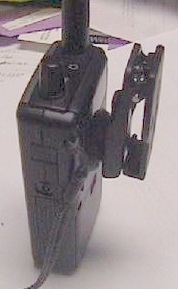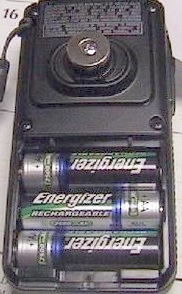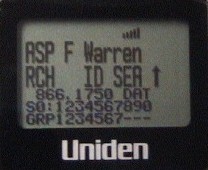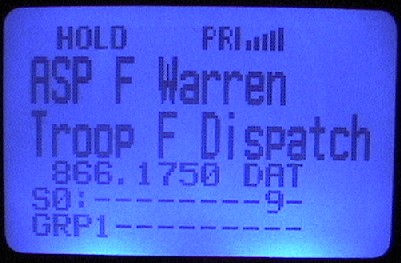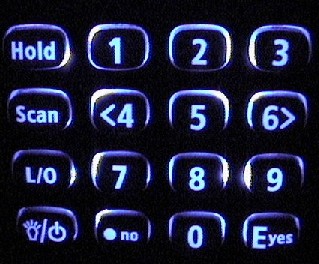The BCD396T is the best scanner I have ever used, period. I really like the memory setup that is similar to the BC246T. The dynamic memory makes programming multiple trunking systems a snap and I never worry about running out of memory or “banks” like in older scanners when programming multiple trunking systems is near impossible at times. The dynamic memory setup allows you to easily group various agencies or frequencies together. In a system, I personally always group all of my fire in one group, police in a separate group, EMS in another group, etc. With 6000 channels regardless if you use text or not, you will find it hard to use all of the memory. It can be done, but I don't see myself using all of the possible memory. I have programmed every county in the state of Arkansas (fire, police, and EMS) along with virtually all of the public safety trunking systems in Arkansas and much of North Louisiana conventional and trunking and I have only used 66% of the available memory. Very impressive!
I love the bright blue backlight. It really stands out and is easily seen in the dark and in direct sunlight. There are numerous settings for the backlight including a timed light (10 and 30 seconds), key press 10 second and infinite, and also backlight with squelch. The 100 quick keys is a very welcome addition to the BCD396T. The BC246T only had 10 quick keys to access systems. This limited your ability to access your programming. Adding the 100 quick keys to the BCD396T allows you to unlock the potential of the dynamic memory.
Fire Tone Out (FTO) is a great feature added to the BCD396T. It is somewhat difficult to find the information needed to program the FTO but if you have access to the information via a fire dept, radio programmer, or some info can be found at the radio reference database, it is a great feature. You cannot scan and use the FTO at the same time. FTO works similar to the SAME weather alert feature, where the scanner must be in standby mode while waiting for a fire tone to activate the FTO. A nice feature added by Uniden via a firmware update is if a dept uses the same radio frequency but different tone frequencies for different groups like EMS, FIRE, Rescue, etc., the FTO feature will monitor all programmed FTO settings using the same radio frequency and activate on the group that is paging.
The Close Call feature on the BCD396T is the same as that on the BC246T and Pro-83 scanners. This is a great feature when you are close enough to the transmitting source. If you don't expect the close call feature to catch frequencies over 100' away, you'll enjoy the feature, especially if you happen up on an accident, fire screen or other incident where you don't know the agencies involved. You can use the close call feature while scanning your programmed frequencies which is a great feature. You can also use a search and store feature with the close call that automatically stores the found frequency to a system. I have picked up a close call hit form as much as 1/2 mile away from a repeater but this is not typical. Mostly it will be a close proximity feature. The BCD396T has a great alert feature. You can set the scanner so that it alerts you when there is activity on a channel you specify.
Custom Alerts For each alert in the scanner (such as channel alert, Close Call alert, emergency alert), you can select from 9 different tone patterns and also set the alert volume level independently from the main volume level. This works great for me because I set different alerts for different fire depts. in my area. I hear the unique alert and without looking I automatically know which fire department is transmitting.
The single knob on the top that acts as a volume, squelch, and scroll knob is a good idea. I'd like a separate knob for squelch but this one works well. It simplifies the top of the scanner. The squelch isn't as sensitive as I'd like it to be. The squelch has to be set to 0 to open up (cause static). I usually keep it set at 2 with no problems. When you adjust the squelch and volume, there is a digital readout on the screen that shows 0 to 15 on both squelch and volume. If you push the knob down, you will see the volume bar on the screen along with a volt meter in the top right of the screen. The volt meter isn't mentioned in the manual but is a great “hidden” feature.
A couple of other unmentioned feature is that this scanner will do I-Calls on a 9600bps digital system. This is something that other digital scanners can't do. Also there is a feature that is similar to the 246, a frequency counter. While powering on press (Hold, 3, and 0) and the scanner will be a frequency counter for the frequency range specified.
There is also a signal strength meter on the screen of the BCD396T that I like. I missed having a signal meter on the BC246T and am glad to see it made it to the 396. The screen has an adjustable contrast which I find useful at times. This scanner has the SAME weather alerts and weather alert priority like the BC246. As with the 246T, I like the fact that you can use the weather alert priority while scanning. It does cause a skip every 10 seconds in a transmission you are hearing. That pause you hear is when the scanner is checking for activity from the local NOAA weather transmitter. I use the SAME feature (which must be in standby mode) at night when my area is expecting severe weather. I think this is a great feature to add to a scanner. I hope all future scanners keep this feature. I don't use it often, but I do appreciate it when I need it.
The BCD396T comes with everything you need unlike Pro-Series scanners. The BCD396T includes a PC Programming cable, 3 rechargeable batteries, AC adapter, BNC/SMA adapter, belt clip, SMA antenna, wrist strap, and free downloadable full version programming software. The software is a little difficult to navigate at first but makes programming this scanner much easier than doing it by hand. The belt clip included with the scanner is the first of its kind on a scanner. I really like the swivel style belt clip. The clip makes carrying the scanner more pleasant than other scanners. Because of the size of the scanner along with the belt clip style I find myself carrying the scanner everywhere I go. The belt clip holds the scanner firmly in place on a belt or clipped to the pocket. The wrist strap is a nice addition as well. I use it when holding my scanner and it has prevented the $525.00 investment from hitting the ground.
The scanner comes preprogrammed with hundreds of frequencies and systems from all over the US, none of which were in my area so I deleted them. If I travel to an area, I can reload them via the software provided by Uniden. The audio on this scanner is much louder than that of the 246T. If you open the radio all the way to full volume, the audio is loud and clear. It doesn't distort like the 246T does. The pitch of the audio is different than that of the 246. The 246 has a deeper pitch whereas the 396 has a higher pitch (more treble) sound. Analog audio comes in very well on the 396T. I haven't had a chance to monitor a digital system as of yet, my area is to change over Mid-September 2005 and I will report back after I have had a chance to monitor the new digital system for a month or two. The reception of the BCD396T is really good on 800 MHz and VHF-High with the supplied SMA antenna. I would likely buy an antenna dedicated to 800 if I lived in an area with multiple 800 systems but I only have 1 in my area and will likely stick to the supplied antenna.
I like the fact that Uniden has given us the feature of search with scan. While scanning my programmed frequencies I can set up one or more custom search of a frequency range and/or the preprogrammed service searches. This is a great feature if you are searching for new frequencies or just want to monitor for instance the HAM frequencies.
Battery life of the BCD396T averages between 8 to 12 hours depending on backlight usage, radio activity, and battery type. I use mostly Energizer 2500 mAh rechargeable batteries. But I also use the stock 2300 mAh and Energizer 2200 mAh. The 2500 obviously last longer than the 2200 but not by much, maybe an hour. I think that battery life is relatively good considering all of the features that are used by this scanner. I normally leave the backlight on and have moderate activity and get 8 hours out of a set of 2500 mAh batteries. Without the backlight on at all I have gotten 12 hours from 2500 mAh's. I haven't had the chance to use the scanner on a digital system so battery life may decrease when digital decoding begins, again, I'll report on that in a couple of months.
The size of this scanner is one of its best features. Like the 246, the compact design is definitely a plus to those of us who want to take the scanner where ever we go. Though the scanner is small, that doesn't mean that the display is hard to see. The text used and size of the display makes it easy to see and has plenty of information on the screen. The screen displays your system you are monitoring, the group, and the user. Pressing FNC + 5 easily allows you to see the frequency that is being used which could not be done with the BC246T. Also displayed is the system quick key and group quick keys. Other info is also displayed if selected like priority, att, channel modulation, etc. Another feature I didn't see mentioned in the manual is an activity display on trunking systems. When pushing the volume knob down briefly during the monitoring of a trunked system, you'll see the volume displayed and above that is a line that displays trunking activity. You'll see marks on the line for every user that is talking on the system. It is a neat feature but is kind of useless to me.
The BCD396T has the Trunk Tracker IV Operation Follows unencrypted conversations on analog Motorola, Motorola Astro 25 (APCO 25), EDACS, EDACS SCAT, and LTR trunked radio systems, including systems in VHF, UHF, 700 MHz, 800 MHz, and 900 MHz bands. The scanner can scan both conventional and trunked systems at the same time. I like the addition of the 700 MHz trunking capability. More and more public safety agencies will be moving to 700 systems in the future and this scanner will be ready for them. Also not mentioned is the fact that this scanner will trunk the 380 to 400 range used by the U.S. Military. All in all, this scanner is the best hand held scanner ever made in my opinion. It is worth every penny. With most dealers charging from $519 to $550, it is a steal with all of the features that is included in this scanner. Uniden has done an excellent job with adding features and keeping prices reasonable. I would recommend this scanner to anyone serious about scanning. I believe this to be the ultimate scanner at this time. But as we know, like a computer, it will likely be replaced in a couple of years or out done by a competitor like GRE. We will have to wait and see.
Digital Sound Quality and Performance: I have been using my BCD396T on the Arkansas P25 digital system for over a year. I am pleased with the performance of the scanner on the system. I did have to adjust the audio settings as described in the manual. But after doing that, sound is as clear if not better than the old analog system. BCD396T performs great on this system. The scanner doesn’t miss any transmissions or cut them off during the transmission. I use the system hold time at 0 and have no problems whatsoever with the new system. I am glad I bought the BCD396T and I would highly recommend it to anyone that is interested.
